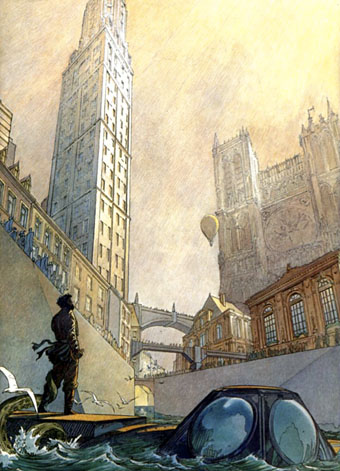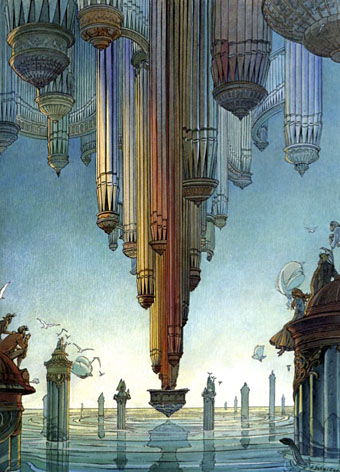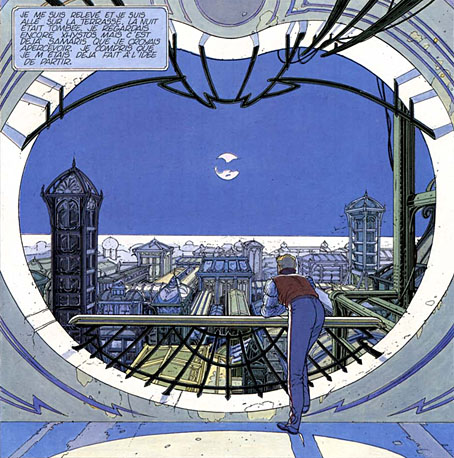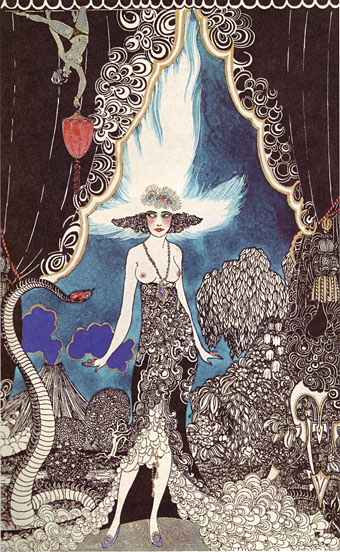Hitchcock and Borges revisited | Johan Grimonprez’s new film, Double Take.
Category: {borges}
Jorge Luis Borges
Weekend links 4
Will at A Journey Round My Skull turned up this hand-coloured picture from Ronald Balfour’s illustrated Rubáiyát some of whose other drawings were featured here recently. That distant volcano is a curious detail. Related: Golden Age Comic Book Stories posted plates from Willy Pogány’s edition.
• Authors on authors: China Miéville on JG Ballard; Rodrigo Fresán on Jorge Luis Borges; AS Byatt on Lewis Carroll.
• Events: Alan Moore & Sunn O)))’s Stephen O’Malley present Simultaneous Conjugation of Four Spirits in a Room at the Laing Art Gallery on March 13th, 2010 (via Arthur); in October Weirdstone will celebrate the fiftieth anniversary of Alan Garner’s The Weirdstone of Brisingamen.
• New blogs: Wonder Kabinet / Wunderkammer, “curiosities, ephemera, and fragments from The Cutting Room Floor and Evan J Peterson”; Pencil Tool, a Tumblr by Charity Pomaybo; and another Tumblr from Mountain*7.
• Perversity Think Tank is a new book from Supervert. Download it for free or order the delicious limited edition.
• The Casual Optimist lists 10+ Flickr Groups for Book Design and Inspiration.
• Via BibliOdyssey: 400 woodcuts by Eric Gill.
• “At least in self-abuse / There’s a little dignity…” Song of the week was Hands 2 Take by The Flying Lizards from their second album, Fourth Wall (1981). I bought this when it came out but hadn’t listened to it for years. Thrilling, urgent stuff with the fabulous Patti Palladin on vocals. Play loud.
Jorge Luis Borges’s lost translations
Jorge Luis Borges’s lost translations | A dispute with Borges’s estate has left works he produced with the translator Norman Thomas di Giovanni in publishing limbo.
Echoes of the Cities

Mysterieux retour du Capitaine Nemo.
This week has been incredibly hectic work-wise but I’ve managed to keep these posts going, so here’s the last one devoted to an appreciation of the Cités Obscures of François Schuiten and Benoît Peeters. A week of posts barely scratches the surface of their vast and involved creation of alternate worlds, fantasy design and architecture, and Borges-like metaphysical speculation. When I try to explain my disaffection with the popular end of American comics, it’s works such as these which I offer as an alternative. The problem, of course, is that only a handful of the books have been translated into English, a detail which tells you all you need to know about English-speaking comics publishers and—since demand fuels the market—their readers.
This final set of pictures is a selection from Schuiten and Peeters’ L’Echo des Cités (1993), a facsimile edition of the main newspaper which serves the cities of the Obscure World. Unfortunately, this remains untranslated but the bulk of the book is full-page illustrations, many of which are among Schuiten’s best. A number of these were later reprinted as limited lithograph prints.

Les rêves engloutis d’Oscar Frobelius.
Les Murailles de Samaris by Schuiten & Peeters

The Obscure World.
Les Murailles de Samaris (1983) by François Schuiten and Benoît Peeters is the first of the stories which explores the world of Les Cités Obscures, a “counter-Earth” on the opposite side of our Sun with a continent of separate city-states, each with their own distinct architectural style. Having discovered these stories first in their French editions it wasn’t immediately apparent how much the Obscure World was supposed to be connected to our own; a number of the books contain references to people or places in our world, while the city of Brüsel, subject of the book of that name, is a kind of parallel Brussels. The counter-Earth explanation isn’t given in the early books but seems to have evolved later, as does Schuiten and Peeters’ introduction of portals between the worlds which imply a two-way leakage of influence. Writer and artist encourage readers of the series to suggest or “discover” new portals to the Obscure World.

A view over Xhystos.
The distant city of Samaris is the mysterious destination of Les Murailles de Samaris (The Walls of Samaris). The story begins in the city of Xhystos whose style is fully Art Nouveau in a manner reminiscent of the celebrated Belgian architect Victor Horta, if Horta had been allowed to design a city where every building is decorated with wrought-iron curves and glass-canopied roofs, and where trams go by on elevated roads several storeys high. The narrator, Franz, is informed by the city authorities that he’s been chosen to go on a perilous mission to discover whether rumours about the nature of Samaris are true or not. Previous explorers have failed to return so Franz’s friends and girlfriend regard his acceptance of the mission as suicidal. What follows is a journey by steam train out of the city into a surrounding zone of lawless ruins, then a journey by “altiplane” and “aerophele”, the latter being a kind of multi-winged sand yacht.
Continue reading “Les Murailles de Samaris by Schuiten & Peeters”

